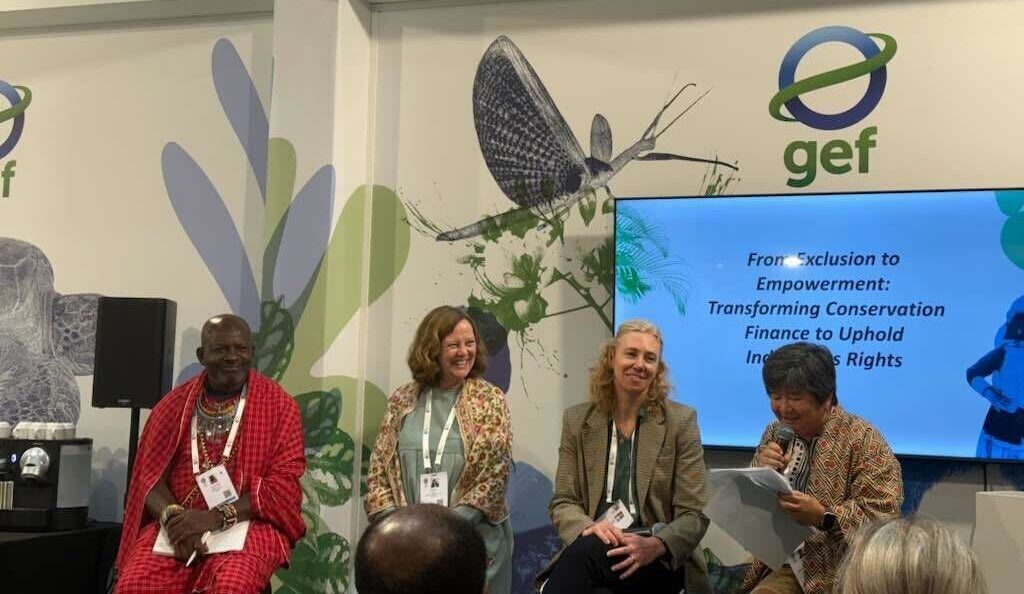
IUCN World Conservation Congress 2025 panel, ‘From Exclusion to Empowerment: Transforming Conservation Finance to Uphold Indigenous Rights’. Panelists, left to right: Malih Ole Kaunga (Founder and Executive Director, IMPACT Kenya), Stefanie Lang (Executive Director, Legacy Landscapes Fund), Annie Mark (Senior Director, Global Partnerships, Environmental Defense Fund) and Joan Carling (Executive Director, Indigenous Peoples Rights International)
By Aarthi Sivaraman and Annie Mark
Our world is at a crossroads today. The biodiversity crisis is accelerating, with forests, rivers, and ecosystems that sustain people and wildlife under the growing strain of climate shocks. Worryingly, the global commitment to conservation funding is wavering even as the stakes rise.
For example, Germany, long a leader in financing Indigenous tenure rights, is openly debating cuts, while development and climate finance face serious headwinds in the United States. Around the world, conservation is at risk of slipping down the agenda. But here’s the problem: the demand for action has never been louder.
We know this because Environmental Defense Fund, along with its partners in the Coalition for Nature & People undertook research across Brazil, Zambia, and Indonesia to better understand how conservation projects funded by Official Development Assistance (ODA) are perceived and experienced by communities.
Interviews with Indigenous leaders and experts, and nationally representative polling confirm that we are in a delicate moment: there is strong public demand for conservation, but it is underpinned by skepticism about whether it will be delivered in ways that last.
- 84% of respondents said protecting nature is a top national priority.
- 86% expressed support for internationally funded conservation projects in their country.
- 73% agreed that Indigenous Peoples and local communities should hold leadership roles in those projects.
- Expert interviews confirmed that conservation outcomes are consistently stronger when communities themselves are decision-makers.
These findings capture the paradox of this moment. Public will is clear. Community leadership works. Yet international support is uncertain, and the funding situation remains fragile.
And that’s why the role of international non-governmental organizations (INGOs) like EDF is so pivotal now: not to replace community leadership, but to build bridges, convene partners, and amplify voices in a moment when conservation needs both urgency and legitimacy. That responsibility endures even as politics and funding realities shift. That means those that adapt and listen will remain relevant while those that don’t will quickly lose ground.
Recent global convenings, like the IUCN World Conservation Congress echoed this direction: progress depends not only on channeling more finance, but also how support is structured: flexible, rights-based, and aligned with locally-defined priorities. That means moving beyond grants alone to strengthen decision-making power, simplify burdensome reporting that can be culturally inappropriate, and reduce reliance on intermediaries so communities can steer their own outcomes. It also means addressing gaps in visibility and finance for African Indigenous Peoples and local communities (IPLCs), even as momentum grows in regions like the Amazon.
The good news is that we are making progress. Organizations like the Global Environment Facility (GEF) are pledging to direct 20% of resources to Indigenous Peoples and local communities; and the Legacy Landscapes Fund opened a funding window for Indigenous Peoples. Mechanisms such as the Tropical Forever Finance Facility (TFFF) point toward models where IPLCs are true co-owners with flexible funding and streamlined accountability, pairing resources with secure rights and real authority.
Why does that matter? Because nature is our life-support system. It shelters wildlife, sustains livelihoods, and holds the key to climate resilience. Conservation succeeds when it is rooted not in top-down control, but in human rights and equity.
The good news is we have a clear arc to build on. Last year, the Convention on Biological Diversity (CBD) strengthened the formal voice of Indigenous Peoples. As we look toward Belém and COP30, four priorities are rising: 1) Increase the share of climate finance that reaches IPLCs directly; 2) Recognize Indigenous and local territories as vital carbon sinks in policy; 3) Embed traditional knowledge in adaptation metrics; 4) Ensure meaningful participation and decision-making.
These are the partnership standards EDF is working to advance.
The public mandate for conservation is strong and evidence of community-led effectiveness is overwhelming. What remains is to close the gap between demand and delivery and to ensure that the future of conservation is one that empowers people as much as it protects nature. INGOs have a once-in-a-generation opportunity to do so, as conveners and partners who help communities lead.
This work cites the Coalition for Nature & People, a partnership of Environmental Defense Fund, WWF Germany, The Nature Conservancy, Legacy Landscapes Fund, and Peace Parks Foundation.









